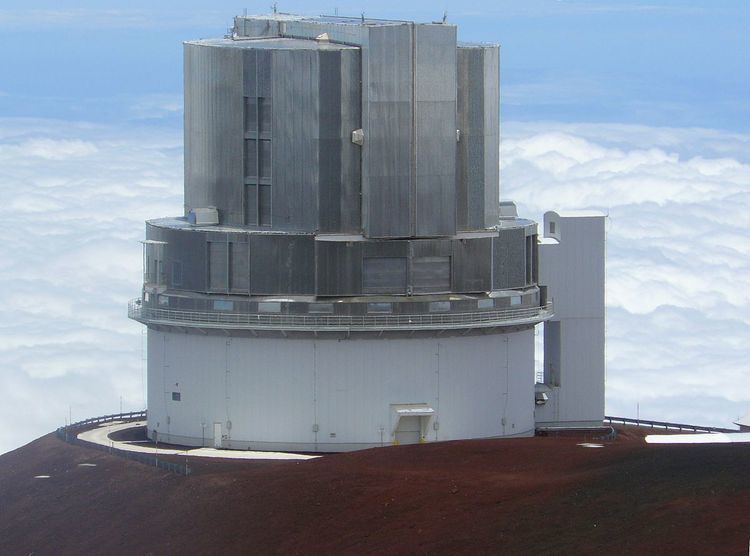Altitude 4,139 m (13,579 ft) Built Completed 1998 | Wavelength Optical/Infrared | |
 | ||
Address John A. Burns Way, Hilo, HI 96720, USA Similar National Astronomical Observat, Mauna Kea, W M Keck Observatory, Mauna Kea Observatories, Thirty Meter Telescope Profiles | ||
Subaru Telescope (すばる望遠鏡, Subaru Bōenkyō) is the 8.2-metre flagship telescope of the National Astronomical Observatory of Japan, located at the Mauna Kea Observatory on Hawaii. It is named after the open star cluster known in English as the Pleiades. It had the largest monolithic primary mirror in the world from its commission until 2005.
Contents
Overview
Subaru is a Ritchey-Chretien reflecting telescope. Instruments can be mounted at a Cassegrain focus below the primary mirror, in enclosures on either of two Nasmyth focal points on the sides of the telescope mount, to which light can be directed with a tertiary mirror, or, in an arrangement rare on large telescopes, at the prime focus, in lieu of a secondary mirror, to provide a wide field of view suited to deep wide-field surveys.
In 1984, the University of Tokyo formed an engineering working group to study the concept of a 7.5-metre telescope. In 1985, the astronomy committee of Japan's science council gave top priority to the development of a "Japan National Large Telescope" (JNLT), and in 1986, the University of Tokyo signed an agreement with the University of Hawaii to build the telescope in Hawaii. In 1988, the National Astronomical Observatory of Japan was formed through a reorganization of the University's Tokyo Astronomical Observatory, to oversee the JNLT and other large national astronomy projects.
Construction of the telescope began in April 1991, and later that year, a public contest gave the telescope its official name, "Subaru Telescope." Construction was completed in 1998, and the first scientific images were taken in January 1999. In September 1999, Princess Sayako of Japan dedicated the telescope.
A number of state-of-the-art technologies were worked into the telescope. For example, 261 computer-controlled actuators press the main mirror from the back to correct its distortion when the telescope changes its orientation. The telescope enclosure building is also shaped to minimize air turbulence, to improve the quality of astronomical images.
Subaru is one of the few state-of-the-art telescopes to have ever been used with the naked eye. For the dedication, an eyepiece was constructed so that Princess Sayako could look through it directly. It was enjoyed by the staff for a few nights until it was replaced with the much more sensitive working instruments.
Subaru is the primary tool in the search for Planet Nine, which is expected to take up to five years.
Accidents during construction
Two separate incidents claimed the lives of four workers during the construction of the telescope. On October 13, 1993, 42-year-old Paul F. Lawrence was fatally injured when a forklift tipped over onto him. On January 16, 1996, sparks from a welder ignited insulation which smoldered, generating noxious smoke that killed Marvin Arruda, 52, Ricky Del Rosario, 38, and Warren K. "Kip" Kaleo, 36, and sent twenty-six other workers to the hospital in Hilo. All four workers are memorialized by a plaque outside the base of the telescope dome and a sign posted temporarily each January along the Mauna Kea access road.
Mishap in 2011
On July 2, 2011, the telescope operator in Hilo noted an anomaly from the top unit of the telescope. Upon further examination, coolant from the top unit was found to have leaked over the primary mirror and other parts of the telescope. Observation using Nasmyth foci resumed on July 22, and Cassegrain focus resumed on August 26.
Instruments
Several cameras and spectrographs can be mounted at Subaru Telescope's four focal points for observations in visible and infrared wavelengths.
